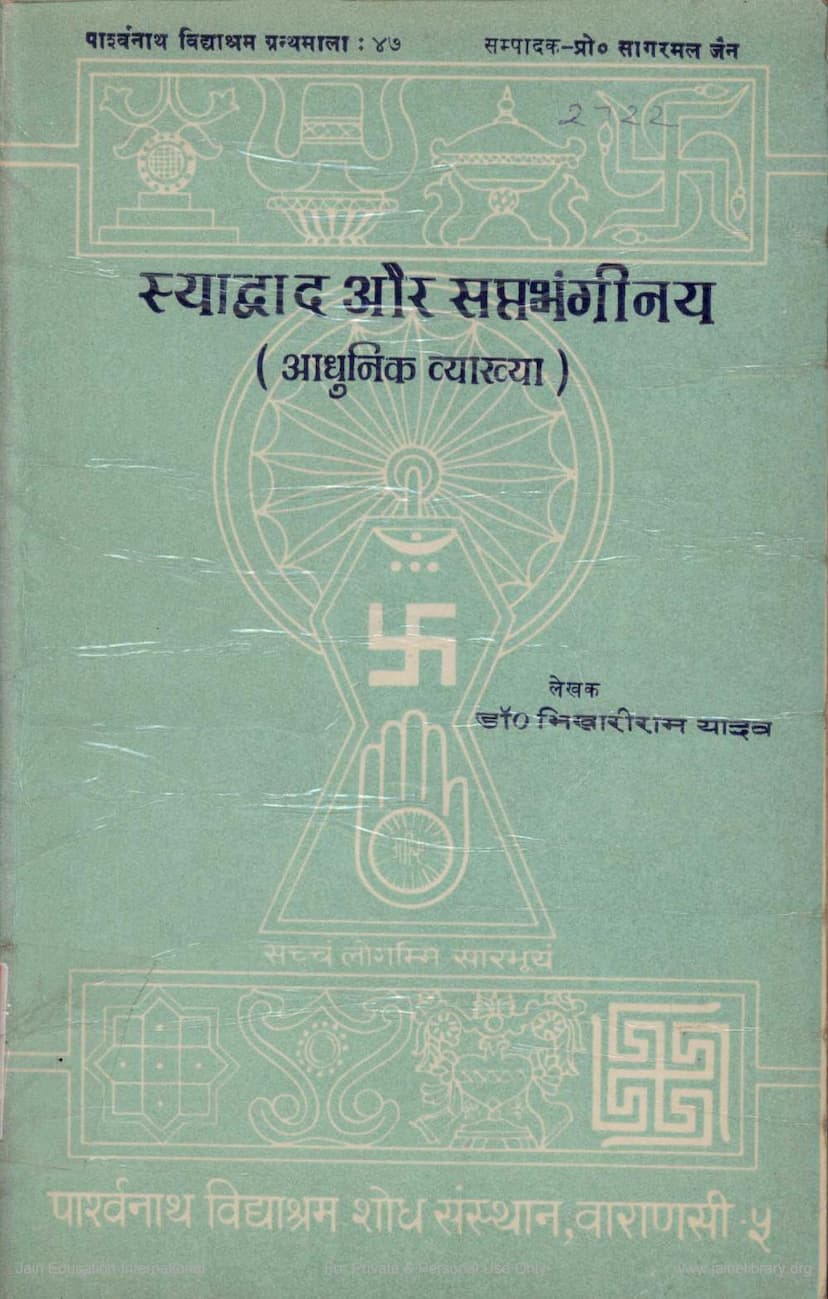Syadvada Aur Saptabhanginay
Added to library: September 2, 2025

Summary
This is a comprehensive summary of the Jain text "Syadvada aur Saptabhanginay (Adhunik Vyakhya)" by Dr. Bhikhariram Yadav, based on the provided pages:
Book Title: Syadvada aur Saptabhanginay (Adhunik Vyakhya) - Syadvada and the Seven-Valued Logic (Modern Interpretation) Author: Dr. Bhikhariram Yadav Publisher: Parshwanath Shodhpith Varanasi Catalog Link: https://jainqq.org/explore/002082/1
This book, published in 1989, presents a modern interpretation of two fundamental concepts in Jain philosophy: Syadvada (the doctrine of conditional predication) and Saptabhanginay (the seven-valued logic or the seven-fold predication). The preface, authored by Prof. Sagarmal Jain, highlights the importance of these concepts in resolving philosophical conflicts, just as Ahimsa resolves practical conflicts.
The book is structured into six chapters, delving into the development of the anekantic (non-one-sided) perspective, the relativistic nature of Syadvada, the authenticity of knowledge and speech, the development of the Angavada (theory of 'bhangas' or predications), an evaluation of Saptabhangi in the context of contemporary logic, and a concluding summary.
Key Concepts and Arguments Presented:
-
Anekantavada (Non-one-sidedness):
- Jainism posits that reality is "ananta-dharmakam vastum" (possessing infinite characteristics).
- The book traces the historical development of this view from the Upanishads, Buddhist literature (particularly the Buddha's critique of extreme views and his concept of Vibhajyavada), and Jain Agamas.
- It argues that these earlier philosophical traditions, while addressing contradictions, often leaned towards either nihilism (Shunyavada) or eternalism (Shashwatavada).
- Mahavira, in contrast, adopted a positive (Vidhayak) approach, accepting multiple perspectives and synthesizing them. He recognized that opposing viewpoints could hold partial truths.
- The infinite characteristics of reality lead to Anekantavada, which states that a single entity can possess multiple, even seemingly contradictory, properties from different standpoints (Apeksha).
-
Syadvada (Relativistic Viewpoint):
- Syadvada is presented as the linguistic expression of Anekantavada.
- The term "Syadvada" is derived from "Syat" and "Vada." "Syat" signifies a specific viewpoint or perspective, and "Vada" means statement or predication. Thus, Syadvada is a relativistic statement.
- It refutes the misconception that "Syat" implies doubt or uncertainty ("perhaps," "maybe"). Jain scholars universally interpret "Syat" as denoting a particular viewpoint or conditionality, not doubt.
- The book emphasizes that Syadvada is necessary due to:
- The infinite characteristics of reality.
- The limitations of human knowledge acquisition tools (senses and intellect).
- The inherent incompleteness and relativity of human knowledge.
- The limited expressive capacity and relativity of language.
- Syadvada ensures that statements are not absolute but conditional, respecting other perspectives and avoiding contradiction.
-
The Seven-Valued Logic (Saptabhanginay):
- Saptabhanginay is the linguistic formulation of Syadvada. It is a system of seven predications used to describe reality from different viewpoints.
- These seven predications are formed from three basic propositions: "is" (Asti), "is not" (Nasti), and "is indescribable/inexpressible" (Avaktavya).
- The seven propositions are:
- Syat Asti: From a certain perspective, it is.
- Syat Nasti: From a certain perspective, it is not.
- Syat Asti Nasti Cha: From a certain perspective, it is and it is not.
- Syat Avaktavya: From a certain perspective, it is indescribable.
- Syat Asti Cha Avaktavya Cha: From a certain perspective, it is and it is indescribable.
- Syat Nasti Cha Avaktavya Cha: From a certain perspective, it is not and it is indescribable.
- Syat Asti Nasti Cha Avaktavya Cha: From a certain perspective, it is, it is not, and it is indescribable.
- The book meticulously analyzes each of these 'bhangas' (predications), providing philosophical context and elaborating on their meaning and application.
- It discusses the historical development of these concepts, noting that while the core ideas of 'Asti,' 'Nasti,' and 'Avaktavya' (or their predecessors) can be traced to Vedic and Buddhist traditions, Jainism systematized them into the seven-fold logic.
- The author critically examines attempts to map Saptabhangi onto modern Western logics, particularly multi-valued logic and modal logic, arguing that while there are formal similarities, the underlying philosophical context is distinct.
-
Authenticity of Knowledge and Speech:
- The book explores the criteria for valid knowledge (Pramana) and authentic speech in Jainism.
- It differentiates between knowledge that is self-validating (Svatah Pramana) and that which relies on external validation (Paratah Pramana).
- The discussion on language highlights the limitations of words in fully capturing the infinite nature of reality, leading to the necessity of nuanced and conditional statements.
-
Critique of Modern Interpretations and Formulation:
- Dr. Yadav critically analyzes modern scholars' interpretations of Syadvada and Saptabhangi, particularly those who try to map it directly onto Western logical systems like two-valued or three-valued logic.
- He argues against classifying Saptabhangi as merely three-valued or even seven-valued in a direct sense, suggesting that its richness lies in its sophisticated relational and conditional nature rather than simply assigning numerical truth values.
- The author proposes a symbolic representation of Saptabhangi using logical operators and conditional statements, aiming for greater clarity and precision in understanding its structure. He also suggests that Saptabhangi implies a "seven-valued" logic in the sense of seven distinct logical standpoints or predicates that can be applied to reality.
Overall Significance:
"Syadvada aur Saptabhanginay (Adhunik Vyakhya)" is a scholarly work that aims to present the profound and complex doctrines of Syadvada and Saptabhanginay in a modern context. Dr. Yadav's work is notable for its attempt to bridge ancient Jain philosophy with contemporary logical and philosophical discourse, offering a detailed and analytical exploration of these foundational principles. The book serves as a valuable resource for understanding the Jain approach to knowledge, reality, and linguistic expression, emphasizing the importance of multiple perspectives and contextual understanding.